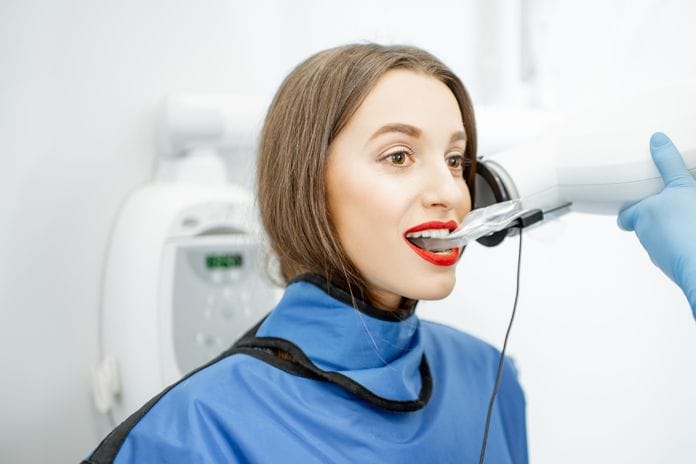Substantial evidence demonstrates a significant increase in the use of medical imaging. Computerized tomography and ionizing radiation imaging have improved medicine and dentistry in many ways. The ability to use digital imaging has eliminated many invasive exploratory procedures. Medical professionals can more easily diagnose many conditions and diseases.
A statement by the U.S. Food & Drug Administration (FDA) declared, “The discovery of X-rays and the invention of CT represented major advances in medicine. X-ray imaging exams are recognized as a valuable medical tool for a wide variety of examinations and procedures. They are used to noninvasively and painlessly help to diagnose disease and monitor therapy, support medical and surgical treatment planning and guide medical personnel as they insert catheters, stents, or other devices inside the body, treat tumors, or remove blood clots or other blockages” (FDA, 2019).
The increase in radiation exposure through the use of various medical and dental procedures has increased a patient’s risk for harmful effects of radiation. It is essential that medical professionals and the general population have the ability to protect themselves against the harmful effects of radiation while decreasing their risk altogether.
Exposure Guidelines
It is critical that dental professionals have the skill set to manage risks versus benefits for all digital imaging. A dental professional will need to consider the patient radiation risk as well as their personal risk. It is beneficial for the general population to have a baseline understanding of radiation risks in order to ensure a personal risk versus benefit analysis, such as their accumulative risk.
One website providing information to consumers shared, “The risk associated with medical imaging procedures refers to possible long-term or short-term side effects. Most imaging procedures have a relatively low risk. Hospitals and imaging centers apply the principles of ALARA (As Low As Reasonably Achievable). This means they make every effort to decrease radiation risk. It is important to remember that a person is at risk if the doctor cannot accurately diagnose an illness or injury. Therefore, it could be said that the benefit from medical imaging, which is an accurate diagnosis, is greater than the small risk that comes with using it. Talk to your doctor or radiologist about any concerns you may have about the risks of a procedure.” (Radiology Info, 2019)
Standards and guidelines have been established to protect both a radiation worker and a non-radiation worker. “Standards for Protection Against Radiation” establishes the dose limits for radiation workers. Although the limits vary, depending on the affected part of the body, the annual total effective dose equivalent (TEDE) for the whole body is 5,000 mrem (5 rem)” (U.S. NRC, 2019).
Additional guidelines are for individuals who are not radiation workers. “The dose limit to non-radiation workers and members of the public are two percent of the annual occupational dose limit. Therefore, a non-radiation worker can receive a whole-body dose of no more than 0.1 rem/year from industrial ionizing radiation. This exposure would be in addition to the 0.3 rem/year from natural background radiation and the 0.05 rem/year from man-made sources such as medical x-rays” (NDT, 2014).
It is important that these guidelines be monitored and respected by any individual exposed to ionizing radiation. With growing concerns over the biological effects of radiation, these guidelines are to be valued.
ALARA Rule
Another important aspect to be considered in reducing radiation risk is by following the ALARA (As Low As Reasonably Achievable) rule.
The Centers for Disease Control and Prevention commented, “The guiding principle of radiation safety is ‘ALARA.’ ALARA stands for ‘as low as reasonably achievable.’ This principle means that even if it is a small dose, if receiving that dose has no direct benefit, you should try to avoid it.” (CDC, 2019)
This guiding principle is informal and easy to keep in mind. Three components are recommended to ensure ALARA − time, distance, and shielding. Each of these recommendations is established to ensure a person’s radiation risk is decreased. The CDC details each of these recommendations and elaborates on the significance of each.
“Time simply refers to the amount of time you spend near a radioactive source. Minimize your time near a radioactive source to only what it takes to get the job done. If you are in an area where radiation levels are elevated, complete your work as quickly as possible, and then leave the area. There is no reason to spend more time around it than necessary.” (CDC, 2019)
Secondly, the consideration of keeping a reasonable distance from radiation is strongly recommended. “Distance refers to how close you are to a radioactive source. Maximize your distance from a radioactive source as much as you can. This is an easy way to protect yourself because distance and dose are inversely related. If you increase your distance, you decrease your dose.” (CDC, 2019)
Lastly, the use of shielding will promote protection from radiation exposure. “To shield yourself from a radiation source, you need to put something between you and the radiation source. The most effective shielding will depend on what kind of radiation the source is emitting. Some radionuclides emit more than one kind of radiation.” (CDC, 2019)
The implementation of these three principles is an effective guide for radiation workers to ensure efforts of decreased radiation risks. These are simple principles that can be highly effective and prevent unnecessary radiation risks.
Health Risks for Long Exposures
Radiation protection is necessary to avoid radiation-associated risks. There are health risks that are involved with any amount of exposure to radiation. The greater the exposure, the greater the risks associated.
The FDA stated, “Ionizing radiation is a form of radiation that has enough energy to potentially cause damage to DNA. Risks from exposure to ionizing radiation include a small increase in the possibility that a person exposed to X-rays will develop cancer later in life.” (FDA, 2019)
Although several studies have shown that the risk of developing cancer is deemed a small risk, it is still crucial to be considerate. “There are many factors that may affect a persons’ risk for developing radiation-induced cancers. The risk of developing cancer from medical imaging radiation exposure is generally very small, and it depends on; radiation dose, the lifetime risk of cancer increases the larger the dose and the more X-ray exams a patient undergoes. Patient’s age, the lifetime risk of cancer is larger for a patient who receives X-rays at a younger age than for one who receives them at an older age. Patient’s sex, women are at a somewhat higher lifetime risk than men for developing radiation-associated cancer after receiving the same exposure at the same ages. Body region, some organs are more radiosensitive than others.” (FDA, 2019).
Children are at a higher risk of cell damage than adults. It is highly recommended that lower doses are always used in medical imaging for children.
“Children grow quickly, and their cells are more sensitive to radiation. Since the effects of radiation take years to develop, their youth extends the time for any potential effects from ionizing radiation to occur. But, the radiation doses required to obtain pictures of children are much lower than adult levels. Therefore, the risk associated with a diagnostic medical examination for a child need not be greater than that for an adult, and is often much less.” (Radiology Info, 2019)
A child’s cells are more sensitive to radiation. So it is important that both dental professionals and parents are aware to ensure proper radiation protection for children.
Conclusion
Digital imaging through the use of radiation has significantly improved many medical procedures. Digital imaging is recognized as necessary and advantageous in many circumstances. However, radiation should be respected, and the proper protocols and recommendations should constantly be considered in regard to radiation protection.
The increase in radiation exposure through the use of medical and dental procedures has increased a patient’s risk for the harmful effects of radiation. It is established that the risk exists, which indicates the necessity for radiation protection and safety. Dental professionals, parents, and the general population have the capacity and resources to be advocates for health and protect themselves against the harmful effects of radiation.
Before you leave, check out the Today’s RDH self-study CE courses. All courses are peer-reviewed and non-sponsored to focus solely on high-quality education. Click here now.
Listen to the Today’s RDH Dental Hygiene Podcast Below:
References
- Medical X-ray Imaging. U.S. Food and Drug Administration. Retrieved from https://www.fda.gov/radiation-emitting-products/medical-imaging/medical-x-ray-imaging#risks
- Information for Radiation Workers. United States Nuclear Regulatory Commission. Retrieved from https://www.nrc.gov/about-nrc/radiation/health-effects/info.html#dose
- Exposure Limits. NDT Resource Center. Retrieved from https://www.nde-ed.org/EducationResources/CommunityCollege/RadiationSafety/safe_use/exposure.htm
- Radiology Info. Retrieved from https://www.radiologyinfo.org/en/submenu.cfm?pg=news
- Radiation and Your Health: ALARA – As Low As Reasonably Achievable. Centers for Disease Control and Prevention. Retrieved from https://www.cdc.gov/nceh/radiation/alara.html#tabs-855575-3












